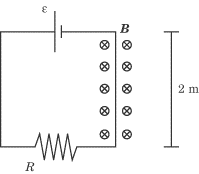Lesson: Chapter - 15
Magnetic Force on Current-Carrying Wires
Since an electric current is just a bunch of moving charges, wires carrying
current will be subject to a force when in a magnetic field. When dealing with a
current in a wire, we obviously can’t use units of
q and v. However,
qv can equally be expressed in terms
of Il, where
I is the current in a wire, and l
is the length, in meters, of the wire—both
qv and Il are
expressed in units of C · m/s. So we can reformulate the equation for the
magnitude of a magnetic force in order to apply it to a current-carrying wire:
Video Lesson

In this formulation,
?
is the angle the wire makes with the magnetic field. We determine the direction
of the force by using the right-hand rule between the direction of the current
and that of the magnetic field.
Example

In the figure above, a magnetic field of
4.0 × 10-5
T is applied locally to one part of an electric circuit with a 5
O
resistor and a voltage of 30 V. The length of wire to which the magnetic field
is applied is 2 m. What is the magnetic force acting on that stretch of wire?
We are only interested in the stretch of wire on the right, where the current
flows in a downward direction. The direction of current is perpendicular to the
magnetic field, which is directed into the page, so we know the magnetic force
will have a magnitude of F = IlB, and will be directed to the right.
We have been told the magnetic field strength and the length of the wire, but we
need to calculate the current in the wire. We know the circuit has a voltage of
30 V and a resistance of
5
O,
so calculating the current is just a matter of applying Ohm’s Law:
align="center" class="body_text">

Now that we know the current, we can simply plug numbers into the equation for
the force of a magnetic field on a current-carrying wire:

Next to display next topic in the chapter.
Practice Questions
Video Lessons and 10 Fully Explained Grand Tests
Large number of solved practice MCQ with explanations. Video Lessons and 10 Fully explained Grand/Full Tests.